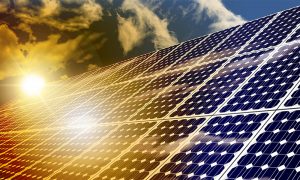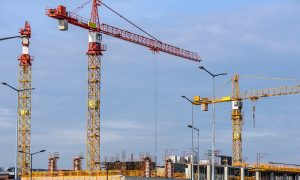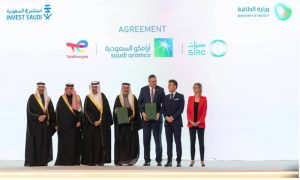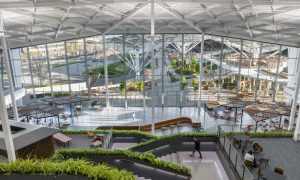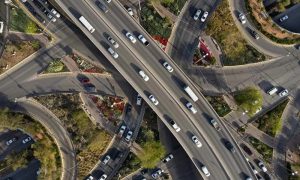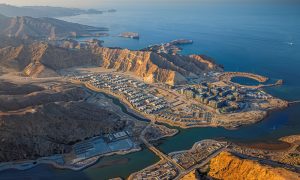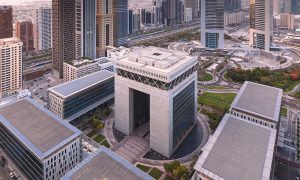Building a beachcomber
It’s full speed ahead on the Al Sufouh tramway, CMME takes a look at how it is staying on track

It’s full speed ahead on the Al Sufouh tramway, CMME takes a look at how it is staying on track
The Hard Rock Cafe, which had stood empty for years as Dubai grew around it, finally saw the demolition crews move in last month, opening a debate as to whether its famous leaning guitars would find another home.
Even as the bulldozers moved in to take the miniature Empire State Building down, there was talk about whether the two concrete instruments could be placed somewhere else. In a metropolis that is barely 40 years old, some residents feel even its kitschest landmarks are worth saving. It’s a small matter that they are barely old enough to go into a restaurant unaccompanied by an adult.
However things have moved on in a district that is one of the city’s unqualified successes of recent years. As the Hard Rock Cafe approaches past tense – as CMME went to press the building was on the brink of being completely taken down – its plot still lies on the dividing lines of the bulging Dubai Media City, the Marina and the popular Jumeirah Beach Residence. Between them they form a triangle that has proven as sturdy as the twin replica guitars since the economic downturn. Close-by is the Jumeirah Palm and the Disneyland-like Madinat which faces the Burj Al Arab. While the heralded Mohammed Bin Rashid City is carefully cultivated over the next decade or so, the area will remain the heart of Dubai’s tourist, residential and glamour industries. All that remains is a way to link it all up.
Enter the Al Sufouh tramway, a 14.5km way to join up Dubai’s most buoyant strands. The project was first announced by Dubai’s Road and Transport Authority in April 2008 and within two months it was awarded to a consortium featuring Astom, Besix, Serco and Parsons. Construction was planned to be divided into two phases. The first phase, which was initially planned to be open by three years later in April 2011, was budgeted at $865 million and included 11 trams which would serve 13 stations along a 9.5km stretch.
The second phase, which would add a further 14 trams and six more stations along an additional 4 km of track. However soon after the announcement, the tramway was suddenly looking precarious. Hit by the global economic downturn, by the close of 2009 (despite the consortium’s determination to lay track down by the end of that year) it seemed it was likely to join other projects such as the Palm Jebel Ali and the Dubai Waterfront on the postponed and possibly abandoned list. Work continued to be disrupted and dogged by a lack of funding. By November, 2010, the project was officially put on hold only to resume in January, 2011 with a third of Phase I almost completed. The works remained slow.
Eventually the official government export credit agencies of Belgium (ONDD) and France (COFACE) – arguably to assist their respective contractors – stepped in to rescue the project. A year after it had restarted, a $401 million was agreed in February 2012 and carving out the route could begin in earnest once more. The project is now heading towards its 2014 deadline at full pace. A fleet of mobile cranes are currently assembling the elevated section which runs alongside the Marina and the Sheikh Zayed Road. Here the tramway will link to the red line of the Dubai Metro. At the other end, Besix tower cranes are constructing the depot which will house the trams and function as the maintenance and service facility. Another crane is deployed overlooking the old Hard Rock Cafe location as it builds a second facility.
Vincent Prou, project director at Alstom, explains that his company has been working with Besix (aka SixConstruct) on the civil works for the project. “They are quite well know here, have worked on Burj Khalifa, and so on.”
He explains their relationship dates back to another Dubai project that never saw reality. “Well it goes back to when they were planning a tramway around the Burj Khalifa tower. They had just finished on it, and we were also bidding for the tramway. So it made sense to work together.”
Alstom has been with the project from the early stage providing conceptual design for the tramway. “It’s a complete turnkey project for us on a design and build basis. So we’re developing the whole project on the behalf of the customer up to completion and revenue and service,” he says. “It’s a complete design, installation, testing and on this project we also have an extended warranty period so we can support the customer in the early stages of the revenue service.”
As part of its turnkey responsibilities, Alstom is providing the entire system for the tramway, including the railway stock, the track, the power supply, signalling telecommunications and various other mechanical equipment such as the platform springdoors, the ticketing, the maintenance machines in the depot and the road signalling. He dwells on the last point. “The difference between the Dubai Metro and the tramway is that it is sharing space with road users,” he says. “With a tram you are crossing a road like a car or a bus.”
That close proximity to the city’s inhabitants has already been felt. With diversions to set up on the roads to accommodate the movement of loaders and mobiles on the 10km-long site. Workers in a nearby office even complained they could feel their desks rumble when piling was used on parts of the route.
“This is a key point,” says Prou. “A major tramway project like this is a major exercise to insert into a city without some disturbance to neighbours and stakeholders. One of the first things we need to do is divert utilities. Everything that is below the track had to be removed.” The popularity of the Metro and the sense a tramway will make to getting around the area disguises the fact that a tramway was never part of the masterplan when it was drawn up over a decade ago.
“No it wasn’t. So, you have to take possession of the tramway and relocate all the services. We have diverted over 50km of HV cables and 10km of drainage and irrigation pipes,” he explains. “Sometimes we spike 8m below the ground; that’s something that’s not very visible when you think of a tramway. You can’t just lay some track put a train on it, and that’s it!”
He adds that building a tramway still has a relatively thin impact over its length but, “once you build a platform, then you don’t access to what is 8m below.” In total, 30 stakeholders ranging from local utility providers such as the Dubai Water and Electricity Authority to developers and landowners had to be approached and negotiated with during the early stages of the project, he explains.
“You have to manage issues of land acquisition because you need to take the land. So you need to interface and reach agreements with these private owners,” he says. “The RTA had defined a corridor at the origin, so the land acquisition had already been made. But in some cases we had to adjust the alignment and reassess the land acquisition. “A good example of that was at the maintenance depot. At one point we faced a problem where we need to completely redesign the layout and concept of the depot so we could have a smaller footprint on the land. Being a design and build project we had the responsibility to develop the design to match the constraints of the environment. It was not like some projects where you have a consultant doing the design and engineering.”
As mentioned before, that particular site is impressive in scope and currently in activity. However, Prou hints that it is not as large as it could potentially be. In fact Alstom has had to use the space intelligently to make the most of it. “It’s been optimised for our needs,” he adds.
“We have designed a concept that manages the flow of trams coming in and out. As a contractor on a design and build project you have the risk but you also have the capability to optimise and mitigate the constraints that you are facing.” Unsurprisingly a project on this scale comes with its limitations: “We are dealing with 3,000 non-objection letters. This is key because if you are not getting the right permits then you’re not working.”
Al Sufouh will be the world’s first open tramway to have all stops aligned with platform screen doors, this allowing for full air conditioning of the system. Giving consistency with other RTA modes, including bus shelters, air conditioning adds to customer appeal in regular temperatures around 40°C. Another innovation is the use throughout of Alstom’s catenary-free APS (Alimentation Par le Sol) system for electricity ground supply to trams whilst overhead.
Although APS has been in use on sections of the Bordeaux tramway since 2003 and is specified for other French cities Angers, Reims and Orléans, this is the first total system application. As with third-rail pick-up being specified for Dubai Metro, the authorities wished to avoid what is considered as visually intrusive overhead line equipment. Having a clear sight-line will also help the experience for both residents and visitors heading to work or the beach.
Prou believes it could lead to a more open-air experience for those normally bound to their cars. “I think it will look great because the city will look different,” he says. “The RTA are using the tramway to regenerate the urban environment. In JBR they have the beach development with restaurants and high end shops. Within walking distance, through nice pedestrian ways you can jump on the tram, connect with the Metro, go to the mall, etc. The whole area will become a nice pleasant areas for everyone. I’m looking forward to seeing that.”

